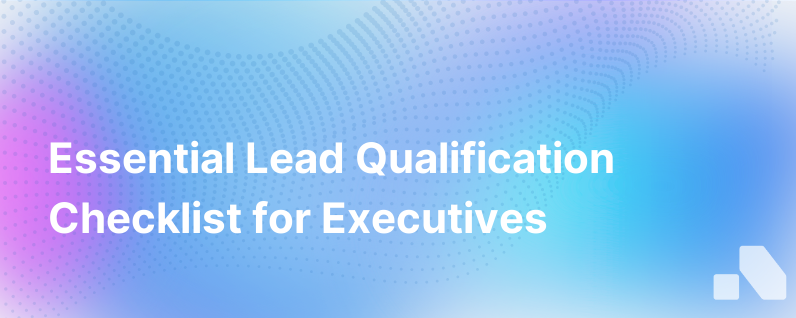Lead Qualification Checklist
Published on December 22, 2023 by David Zhang
Lead qualification is the engine that fuels the sales pipeline with potential opportunities. However, not all leads are created equal, and the key to a productive sales process lies in determining which prospects have the greatest potential to become valuable customers. With limited time and resources, prioritizing leads that are ready and worthy of personal attention becomes essential. A robust lead qualification checklist can guide sales representatives through this filtration process, ensuring the alignment of sales efforts with the most promising prospects.
In this article, we’ll explore the intricacies of an effective lead qualification checklist and how it can transform your sales strategy. This comprehensive checklist serves as a precision tool for identifying high-potential leads, allowing you to focus your energies on nurturing the relationships that are most likely to result in successful sales.
What is Lead Qualification?
Lead qualification is a systematic approach to assess the potential of a lead to become a customer. By filtering through the sea of prospects, a sales team is equipped to concentrate on leads that display a genuine interest or need for the product, coupled with the financial capacity and authority to make a purchase.
The Importance of a Lead Qualification Checklist
Without a clear set of criteria, sales teams may find themselves lost in a vast array of unvetted prospects — wasting time on those that are unlikely to convert. A well-defined checklist provides a structured pathway for evaluating leads, augmenting the efficiency of the sales process by:
- Saving time and resources
- Increasing conversion rates
- Providing a better return on investment (ROI) for marketing and lead generation efforts
- Enhancing sales forecasting accuracy
- Ensuring a consistent qualification process across the sales team
Elements of an Effective Lead Qualification Checklist
Your lead qualification checklist should be a dynamic tool, responsive to the feedback from sales experiences, and adaptable to market shifts. Below is a detailed walkthrough of critical qualifiers to incorporate into your checklist for thorough lead assessment.
1. Lead Source Analysis
- Where did the lead come from? Was it an inbound inquiry, a referral, or generated through outbound efforts?
- What campaign or marketing asset prompted the lead to engage?
- How have leads from this source performed in the past?
2. Demographic Profiling
- Does the lead fit your ideal customer profile (ICP)?
- What is the lead's role and decision-making capacity in their company?
- Is the prospect's industry relevant to your product or service?
3. Behavioral Evaluation
- What actions has the lead taken? (website visits, downloads, webinar attendance)
- Is there engagement with email campaigns or social media posts?
- Has the lead requested more information or a demonstration?
4. Initial Contact Response
- Was the lead responsive to initial contact attempts?
- Did the lead express a clear need that aligns with your product’s value proposition?
- Was the conversation substantive or merely cursory?
5. Budget Consideration
- Does the lead have a defined budget?
- If not, are they in a position to allocate or secure the necessary funds?
- Is their budget in alignment with your pricing structure?
6. Authority Confirmation
- Can the lead authorize or influence the purchasing decision?
- If not, do you have access to, or can you navigate towards, the decision-maker(s)?
7. Need Specification
- Has the lead articulated a clear business challenge that your product or service solves?
- Is there a sense of urgency regarding finding a solution to their problem?
- Are they currently using a competitor's solution, and if so, are they open to switching?
8. Timeline Establishment
- Has the lead defined a timeframe for making a decision or implementation?
- Is their timeline compatible with your sales cycle and capacity for delivery?
9. Obstacle Identification
- Are there identifiable obstacles that could prevent closing the deal? (e.g., internal politics, competing projects)
- What steps can be taken to navigate or mitigate these obstacles?
10. Fit Determination
- Does your product or service match the needs and expectations of the lead?
- Are there any deal-breakers from the lead's perspective that could disqualify your offering?
Integrating the Checklist into the Sales Process
Adopt the checklist as part of a disciplined qualification routine, integrated into your CRM or sales enablement platform for easy application. Sales teams should use the checklist during the initial lead assessment and periodically throughout the nurturing process to reassess lead readiness.
Continuous Checklist Optimization
Evaluate and refine your checklist regularly. Are there recurring trends in leads that convert versus those that don’t? Could the checklist better address these learnings? Feedback from frontline sales experiences is invaluable in this optimization effort.
Conclusion
The refinement of your sales strategy through a well-constructed lead qualification checklist supports a robust, focused approach to conversion. Not only will it shore up your sales funnel with leads who exhibit genuine promise, but it will also align the efforts of your sales team, help manage their time more effectively, and contribute to a more predictable and successful sales outcome. Consider this checklist an evolving cornerstone of your sales process — one that steadily bridges the gap between prospect and profitable customer relationship.
For sales teams encountering a deluge of leads, a checklist-inspired approach coupled with intelligent tools, like those offered by Aomni, can deliver a strategic advantage, equipping your team with finely-tuned insights to transform potential into performance.